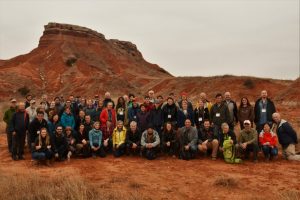From microbiology to geophysics – more than 50 international participants of the first DeepDust Workshop covered a wide range of topics. In Oklahoma researchers exchanged views on a possible international drilling project to study the continental geology of the Permian. During a change from the cold to a warm period, large ice masses melted. This may provide interesting insights into current and future climate developments.
After arriving from all around the globe and sharing a joyful ice breaker, the DeepDust workshop started with an introduction to the International Continental Drilling Program (ICDP) including its setup and possible support for projects. This was followed by an introduction to the Permian, highlighting the interest in Permian equatorial terrestrial geoarchives which may partly serve as Mars analogs. The need for a better understanding of this time period and setting was highlighted clearly. The first afternoon was spent with understanding the challenges of different possible drilling areas.
The second day was spent on an excursion where we saw Permian mudstones, including evaporites and siltstones in Oklahoma. The third day was mostly spent discussing key questions and how these may be answered. Discussions included practicalities such as obtaining site survey data and drill planning. The workshop ended with reviewing major objectives and how these may be achieved efficiently regarding, among others, drilling and funding.
Personally, I really enjoyed participating in such an international and focussed workshop. I learned a lot about the Permian, the Geology of Oklahoma and met many enthusiastic colleagues. I am looking forward to continuing pushing the DeepDust project forward.


Pingback: Stratigraphy, Sedimentology and Palaeontology | The Deep Dust project continues!